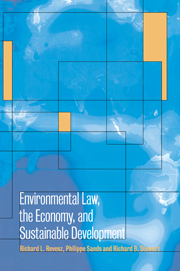 Environmental Law, the Economy and Sustainable Development
Environmental Law, the Economy and Sustainable Development Book contents
- Frontmatter
- Contents
- List of contributors
- Introduction: environmental regulation in multi-jurisdictional regimes
- PART I ENVIRONMENTAL REGULATION IN FEDERAL SYSTEMS
- 1 Federalism and environmental regulation: an overview
- 2 Economic criteria for applying the subsidiarity principle in European environmental law
- 3 The political economy of pollution control in a federal system
- PART II ENVIRONMENTAL REGULATION AND INTERNATIONAL TRADE
- PART III CHOICE OF ENVIRONMENTAL POLICY INSTRUMENTS
- PART IV THE ENVIRONMENTAL STANDARD - SETTING PROCESS
- PART V INTERNATIONAL ENVIRONMENTAL LAW AND SUSTAINABLE DEVELOPMENT
- Index
2 - Economic criteria for applying the subsidiarity principle in European environmental law
Published online by Cambridge University Press: 03 May 2010
- Frontmatter
- Contents
- List of contributors
- Introduction: environmental regulation in multi-jurisdictional regimes
- PART I ENVIRONMENTAL REGULATION IN FEDERAL SYSTEMS
- 1 Federalism and environmental regulation: an overview
- 2 Economic criteria for applying the subsidiarity principle in European environmental law
- 3 The political economy of pollution control in a federal system
- PART II ENVIRONMENTAL REGULATION AND INTERNATIONAL TRADE
- PART III CHOICE OF ENVIRONMENTAL POLICY INSTRUMENTS
- PART IV THE ENVIRONMENTAL STANDARD - SETTING PROCESS
- PART V INTERNATIONAL ENVIRONMENTAL LAW AND SUSTAINABLE DEVELOPMENT
- Index
Summary
Introduction
Professor Revesz discusses three prominent rationales for vesting responsibility for environmental regulation at the federal level: the asserted danger of a “race-to-the-bottom,” the problem of interstate externalities, and the public choice claim that state environmental regulation will be too lax. These three arguments are also relevant in the European context and may play a crucial role in the interpretation of the subsidiarity principle, as formulated in Article 3 B(2) of the EC Treaty. Following this principle, the Community shall take action “only if and in so far as [italics added] the objectives of the proposed action cannot be sufficiently achieved by the Member States and can therefore, by reason of the scale or effects of the proposed action, be better achieved by the Community.” By stressing the need to take the effects of the proposed action into account the EC Treaty itself rejects a pure legal formalistic approach and invites economic analysis. An assessment of the subsidiarity principle that is consistent with economic principles must take into account the implications for social welfare of a diffusion of powers between different levels of government. In a firstbest world environmental standards are decentralized: they are adapted to varying preferences of the population and they take regional diversity (i.e. differing costs and benefits across geographic regions) into account. However, in such a first-best world there are no externalities across jurisdictions. Each state bears the full costs of its own environmental regulation.
- Type
- Chapter
- Information
- Environmental Law, the Economy and Sustainable DevelopmentThe United States, the European Union and the International Community, pp. 80 - 95Publisher: Cambridge University PressPrint publication year: 2000
- 4
- Cited by
